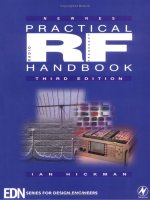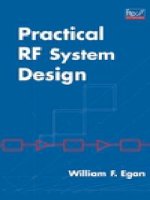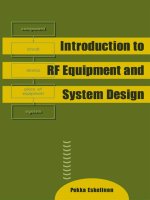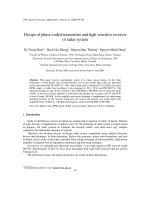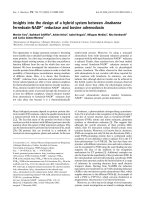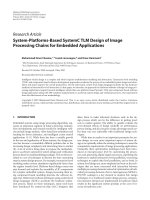Practical RF System Design
Bạn đang xem bản rút gọn của tài liệu. Xem và tải ngay bản đầy đủ của tài liệu tại đây (2.68 MB, 397 trang )
PRACTICAL RF SYSTEM
DESIGN
PRACTICAL RF SYSTEM
DESIGN
WILLIAM F. EGAN, Ph.D.
Lecturer in Electrical Engineering
Santa Clara University
The Institute of Electrical and Electronics Engineers, Inc., New York
A JOHN WILEY & SONS, INC., PUBLICATION
MATLAB is a registered trademark of The Math Works, Inc., 3 Apple Hill Drive, Natick, MA
01760-2098 USA; Tel: 508-647-7000, Fax 508-647-7101; WWW: ;
email:
Figures whose captions indicate they are reprinted from Frequency Synthesis by Phase Lock, 2nd
ed., by William F. Egan, copyright 2000, John Wiley and Sons, Inc., are reprinted by permission.
Copyright 2003 by John Wiley & Sons, Inc. All rights reserved.
Published by John Wiley & Sons, Inc., Hoboken, New Jersey.
Published simultaneously in Canada.
No part of this publication may be reproduced, stored in a retrieval system, or transmitted in any
form or by any means, electronic, mechanical, photocopying, recording, scanning, or otherwise,
except as permitted under Section 107 or 108 of the 1976 United States Copyright Act, without
either the prior written permission of the Publisher, or authorization through payment of the
appropriate per-copy fee to the Copyright Clearance Center, Inc., 222 Rosewood Drive, Danvers,
MA 01923, 978-750-8400, fax 978-750-4470, or on the web at www.copyright.com. Requests to
the Publisher for permission should be addressed to the Permissions Department, John Wiley &
Sons, Inc., 111 River Street, Hoboken, NJ 07030, (201) 748-6011, fax (201) 748-6008, e-mail:
Limit of Liability/Disclaimer of Warranty: While the publisher and author have used their best
efforts in preparing this book, they make no representations or warranties with respect to the
accuracy or completeness of the contents of this book and specifically disclaim any implied
warranties of merchantability or fitness for a particular purpose. No warranty may be created or
extended by sales representatives or written sales materials. The advice and strategies contained
herein may not be suitable for your situation. You should consult with a professional where
appropriate. Neither the publisher nor author shall be liable for any loss of profit or any other
commercial damages, including but not limited to special, incidental, consequential, or other
damages.
For general information on our other products and services please contact our Customer Care
Department within the U.S. at 877-762-2974, outside the U.S. at 317-572-3993 or
fax 317-572-4002.
Wiley also publishes its books in a variety of electronic formats. Some content that appears in
print, however, may not be available in electronic format.
Library of Congress Cataloging-in-Publication Data is available.
ISBN 0-471-20023-9
Printed in the United States of America
10 9 8 7 6 5 4 3 2 1
To those from whom I have learned:
Teachers, Colleagues, and Students
CONTENTS
PREFACE
xvii
GETTING FILES FROM THE WILEY ftp AND INTERNET SITES
xix
SYMBOLS LIST AND GLOSSARY
xxi
1 INTRODUCTION
1.1
1.2
1.3
1.4
1.5
1.6
1.7
1
System Design Process / 1
Organization of the Book / 2
Appendixes / 3
Spreadsheets / 3
Test and Simulation / 3
Practical Skepticism / 4
References / 5
2 GAIN
7
2.1 Simple Cases / 8
2.2 General Case / 9
2.2.1 S Parameters / 9
2.2.2 Normalized Waves / 11
2.2.3 T Parameters / 12
vii
viii
CONTENTS
2.3
2.4
2.5
2.6
3
2.2.4 Relationships Between S and T Parameters / 13
2.2.5 Restrictions on T Parameters / 14
2.2.6 Cascade Response / 14
Simplification: Unilateral Modules / 15
2.3.1 Module Gain / 15
2.3.2 Transmission Line Interconnections / 16
2.3.3 Overall Response, Standard Cascade / 25
2.3.4 Combined with Bilateral Modules / 28
2.3.5 Lossy Interconnections / 32
2.3.6 Additional Considerations / 38
Nonstandard Impedances / 40
Use of Sensitivities to Find Variations / 40
Summary / 43
Endnotes / 45
NOISE FIGURE
3.1
3.2
3.3
3.4
3.5
3.6
3.7
3.8
Noise Factor and Noise Figure / 47
Modules in Cascade / 49
Applicable Gains and Noise Factors / 54
Noise Figure of an Attenuator / 55
Noise Figure of an Interconnect / 56
Cascade Noise Figure / 56
Expected Value and Variance of Noise Figure / 58
Impedance-Dependent Noise Factors / 59
3.8.1 Representation / 60
3.8.2 Constant-Noise Circles / 61
3.8.3 Relation to Standard Noise Factor / 62
3.8.4 Using the Theoretical Noise Factor / 64
3.8.5 Summary / 65
3.9 Image Noise, Mixers / 65
3.9.1 Effective Noise Figure of the Mixer / 66
3.9.2 Verification for Simple Cases / 69
3.9.3 Examples of Image Noise / 69
3.10 Extreme Mismatch, Voltage Amplifiers / 74
3.10.1 Module Noise Factor / 76
3.10.2 Cascade Noise Factor / 78
3.10.3 Combined with Unilateral Modules / 79
3.10.4 Equivalent Noise Factor / 79
47
CONTENTS
ix
3.11 Using Noise Figure Sensitivities / 79
3.12 Mixed Cascade Example / 80
3.12.1 Effects of Some Resistor
Changes / 81
3.12.2 Accounting for Other Reflections / 82
3.12.3 Using Sensitivities / 82
3.13 Gain Controls / 84
3.13.1 Automatic Gain Control / 84
3.13.2 Level Control / 86
3.14 Summary / 88
Endnotes / 90
4 NONLINEARITY IN THE SIGNAL PATH
4.1 Representing Nonlinear Responses / 91
4.2 Second-Order Terms / 92
4.2.1 Intercept Points / 93
4.2.2 Mathematical Representations / 95
4.2.3 Other Even-Order Terms / 97
4.3 Third-Order Terms / 97
4.3.1 Intercept Points / 99
4.3.2 Mathematical Representations / 100
4.3.3 Other Odd-Order Terms / 101
4.4 Frequency Dependence and Relationship
Between Products / 102
4.5 Nonlinear Products in the Cascades / 103
4.5.1 Two-Module Cascade / 104
4.5.2 General Cascade / 105
4.5.3 IMs Adding Coherently / 106
4.5.4 IMs Adding Randomly / 108
4.5.5 IMs That Do Not Add / 109
4.5.6 Effect of Mismatch on IPs / 110
4.6 Examples: Spreadsheets for IMs in a
Cascade / 111
4.7 Anomalous IMs / 115
4.8 Measuring IMs / 116
4.9 Compression in the Cascade / 119
4.10 Other Nonideal Effects / 121
4.11 Summary / 121
Endnote / 122
91
x
5
CONTENTS
NOISE AND NONLINEARITY
123
5.1 Intermodulation of Noise / 123
5.1.1 Preview / 124
5.1.2 Flat Bandpass Noise / 125
5.1.3 Second-Order Products / 125
5.1.4 Third-Order Products / 130
5.2 Composite Distortion / 133
5.2.1 Second-Order IMs (CSO) / 134
5.2.2 Third-Order IMs (CTB) / 136
5.2.3 CSO and CTB Example / 136
5.3 Dynamic Range / 137
5.3.1 Spurious-Free Dynamic Range / 137
5.3.2 Other Range Limitations / 139
5.4 Optimizing Cascades / 139
5.4.1 Combining Parameters on One Spreadsheet / 139
5.4.2 Optimization Example / 143
5.5 Spreadsheet Enhancements / 146
5.5.1 Lookup Tables / 146
5.5.2 Using Controls / 147
5.6 Summary / 147
Endnotes / 147
6
ARCHITECTURES THAT IMPROVE LINEARITY
6.1 Parallel Combining / 149
6.1.1 90◦ Hybrid / 150
6.1.2 180◦ Hybrid / 152
6.1.3 Simple Push–Pull / 154
6.1.4 Gain / 155
6.1.5 Noise Figure / 156
6.1.6 Combiner Trees / 156
6.1.7 Cascade Analysis of a Combiner Tree / 157
6.2 Feedback / 158
6.3 Feedforward / 159
6.3.1 Intermods and Harmonics / 160
6.3.2 Bandwidth / 161
6.3.3 Noise Figure / 161
6.4 Nonideal Performance / 162
6.5 Summary / 163
Endnotes / 163
149
CONTENTS
7 FREQUENCY CONVERSION
xi
165
7.1 Basics / 165
7.1.1 The Mixer / 165
7.1.2 Conversion in Receivers / 167
7.1.3 Spurs / 168
7.1.4 Conversion in Synthesizers and Exciters / 170
7.1.5 Calculators / 170
7.1.6 Design Methods / 170
7.1.7 Example / 171
7.2 Spurious Levels / 171
7.2.1 Dependence on Signal Strength / 171
7.2.2 Estimating Levels / 173
7.2.3 Strategy for Using Levels / 175
7.3 Two-Signal IMs / 176
7.4 Power Range for Predictable Levels / 177
7.5 Spur Plot, LO Reference / 180
7.5.1 Spreadsheet Plot Description / 180
7.5.2 Example of a Band Conversion / 182
7.5.3 Other Information on the Plot / 184
7.6 Spur Plot, IF Reference / 186
7.7 Shape Factors / 196
7.7.1 Definitions / 197
7.7.2 RF Filter Requirements / 197
7.7.3 IF Filter Requirements / 200
7.8 Double Conversion / 202
7.9 Operating Regions / 203
7.9.1 Advantageous Regions / 203
7.9.2 Limitation on Downconversion,
Two-by-Twos / 206
7.9.3 Higher Values of m / 209
7.10 Examples / 211
7.11 Note on Spur Plots Used in This Chapter / 216
7.12 Summary / 216
Endnotes / 217
8 CONTAMINATING SIGNALS IN SEVERE NONLINEARITIES
8.1 Decomposition / 220
8.2 Hard Limiting / 223
8.3 Soft Limiting / 223
219
xii
CONTENTS
8.4 Mixers, Through the LO Port / 225
8.4.1 AM Suppression / 225
8.4.2 FM Transfer / 226
8.4.3 Single-Sideband Transfer / 226
8.4.4 Mixing Between LO Components / 228
8.4.5 Troublesome Frequency Ranges in the LO / 228
8.4.6 Summary of Ranges / 235
8.4.7 Effect on Noise Figure / 236
8.5 Frequency Dividers / 240
8.5.1 Sideband Reduction / 240
8.5.2 Sampling / 241
8.5.3 Internal Noise / 242
8.6 Frequency Multipliers / 242
8.7 Summary / 243
Endnotes / 244
9
PHASE NOISE
9.1 Describing Phase Noise / 245
9.2 Adverse Effects of Phase Noise / 247
9.2.1 Data Errors / 247
9.2.2 Jitter / 248
9.2.3 Receiver Desensitization / 249
9.3 Sources of Phase Noise / 250
9.3.1 Oscillator Phase Noise Spectrums / 250
9.3.2 Integration Limits / 252
9.3.3 Relationship Between Oscillator Sϕ and Lϕ / 252
9.4 Processing Phase Noise in a Cascade / 252
9.4.1 Filtering by Phase-Locked Loops / 253
9.4.2 Filtering by Ordinary Filters / 254
9.4.3 Implication of Noise Figure / 255
9.4.4 Transfer from Local Oscillators / 255
9.4.5 Transfer from Data Clocks / 256
9.4.6 Integration of Phase Noise / 258
9.5 Determining the Effect on Data / 258
9.5.1 Error Probability / 258
9.5.2 Computing Phase Variance, Limits of
Integration / 259
9.5.3 Effect of the Carrier-Recovery Loop on Phase
Noise / 260
245
CONTENTS
xiii
9.5.4 Effect of the Loop on Additive
Noise / 262
9.5.5 Contribution of Phase Noise to Data
Errors / 263
9.5.6 Effects of the Low-Frequency Phase
Noise / 268
9.6 Other Measures of Phase Noise / 269
9.6.1 Jitter / 269
9.6.2 Allan Variance / 271
9.7 Summary / 271
Endnote / 272
APPENDIX A
OP AMP NOISE FACTOR CALCULATIONS
273
A.1 Invariance When Input Resistor Is Redistributed / 273
A.2 Effect of Change in Source Resistances / 274
A.3 Model / 276
APPENDIX B REPRESENTATIONS OF FREQUENCY BANDS,
IF NORMALIZATION
279
B.1 Passbands / 279
B.2 Acceptance Bands / 279
B.3 Filter Asymmetry / 286
APPENDIX C
CONVERSION ARITHMETIC
289
C.1 Receiver Calculator / 289
C.2 Synthesis Calculator / 291
APPENDIX E
EXAMPLE OF FREQUENCY CONVERSION
293
APPENDIX F
SOME RELEVANT FORMULAS
303
F.1 Decibels / 303
F.2 Reflection Coefficient and SWR / 304
F.3 Combining SWRs / 306
F.3.1 Summary of Results / 306
F.3.2 Development / 307
F.3.3 Maximum SWR / 308
F.3.4 Minimum SWR / 309
F.3.5 Relaxing Restrictions / 309
F.4 Impedance Transformations in Cables / 310
F.5 Smith Chart / 310
xiv
CONTENTS
APPENDIX G TYPES OF POWER GAIN
G.1
G.2
G.3
G.4
G.5
Available Gain / 313
Maximum Available Gain / 313
Transducer Gain / 314
Insertion Gain / 315
Actual Gain / 315
APPENDIX H FORMULAS RELATING TO IMs AND
HARMONICS
H.1
H.2
H.3
H.4
H.5
313
317
Second Harmonics / 317
Second-Order IMs / 318
Third Harmonics / 318
Third-Order IMs / 319
Definitions of Terms / 320
APPENDIX I CHANGING THE STANDARD IMPEDANCE
321
I.1 General Case / 321
I.2 Unilateral Module / 323
APPENDIX L
APPENDIX M
POWER DELIVERED TO THE LOAD
MATRIX MULTIPLICATION
APPENDIX N NOISE FACTORS — STANDARD AND
THEORETICAL
N.1
N.2
N.3
N.4
N.5
N.6
Theoretical Noise Factor / 329
Standard Noise Factor / 331
Standard Modules and Standard Noise Factor / 332
Module Noise Factor in a Standard Cascade / 333
How Can This Be? / 334
Noise Factor of an Interconnect / 334
N.6.1 Noise Factor with Mismatch / 335
N.6.2 In More Usable Terms / 336
N.6.3 Verification / 338
N.6.4 Comparison with Theoretical Value / 340
N.7 Effect of Source Impedance / 341
N.8 Ratio of Power Gains / 342
Endnote / 343
325
327
329
CONTENTS
xv
APPENDIX P
IM PRODUCTS IN MIXERS
345
APPENDIX S
COMPOSITE S PARAMETERS
349
APPENDIX T
THIRD-ORDER TERMS AT INPUT FREQUENCY
353
APPENDIX V
FIGURE
SENSITIVITIES AND VARIANCE OF NOISE
APPENDIX X
CROSSOVER SPURS
359
APPENDIX Z
NONSTANDARD MODULES
363
Z.1
Z.2
Z.3
Z.4
Z.5
355
Gain of Cascade of Modules Relative to Tested Gain / 363
Finding Maximum Available Gain of a Module / 366
Interconnects / 367
Equivalent S Parameters / 367
S Parameters for Cascade of Nonstandard Modules / 368
Endnote / 369
REFERENCES
Endnote / 377
371
INDEX
379
PREFACE
This book is about RF system analysis and design at the level that requires an
understanding of the interaction between the modules of a system so the ultimate
performance can be predicted. It describes concepts that are advanced, that is,
beyond those that are more commonly taught, because these are necessary to the
understanding of effects encountered in practice. It is about answering questions
such as:
• How will the gain of a cascade (a group of modules in series) be affected
by the standing-wave ratio (SWR) specifications of its modules?
• How will noise on a local oscillator affect receiver noise figure and desensitization?
• How does the effective noise figure of a mixer depend on the filtering that
precedes it?
• How can we determine the linearity of a cascade from specifications on
its modules?
• How do we expect intermodulation products (IMs) to change with signal
amplitude and why do they sometimes change differently?
• How can modules be combined to reduce certain intermodulation products
or to turn bad impedance matches into good matches?
• How can the spurious responses in a conversion scheme be visualized and
how can the magnitudes of the spurs be determined? How can this picture
be used to ascertain filter requirements?
xvii
xviii
PREFACE
• How does phase noise affect system performance; what are its sources and
how can the effects be predicted?
I will explain methods learned over many years of RF module and system design,
with emphasis on those that do not seem to be well understood. Some are available in the literature, some were published in reviewed journals, some have
developed with little exposure to peer review, but all have been found to be
important in some aspect of RF system engineering.
I would like to thank Eric Unruh and Bill Bearden for reviewing parts of
the manuscript. I have also benefited greatly from the opportunity to work with
many knowledgeable colleagues during my years at Sylvania-GTE Government
Systems and at ESL-TRW in the Santa Clara (Silicon) Valley and would like
to thank them, and those excellent companies for which we worked, for that
opportunity. I am also grateful for the education that I received at Santa Clara
and Stanford Universities, often with the help of those same companies. However,
only I bear the blame for errors and imperfections in this work.
WILLIAM F. EGAN
Cupertino, California
February, 2003
GETTING FILES FROM THE WILEY ftp
AND INTERNET SITES
To download spreadsheets that are the bases for figures in this book, use an ftp
program or a Web browser.
FTP ACCESS
If you are using an ftp program, type the following at your ftp prompt:
Some programs may provide the first “ftp” for you, in which case type
ftp.wiley.com
Log in as anonymous (e.g., User ID: anonymous). Leave password blank. After
you have connected to the Wiley ftp site, navigate through the directory path of:
/public/sci_tech_med/rf_system
WEB ACCESS
If you are using a standard Web browser, type URL address of:
xix
xx
GETTING FILES FROM THE WILEY ftp AND INTERNET SITES
Navigate through the directory path of:
/public/sci_tech_med/rf_system
If you need further information about downloading the files, you can call Wiley’s
technical support at 201-748-6753.
SYMBOLS LIST AND GLOSSARY
The following is a list of terms and symbols used throughout the book. Special
meanings that have been assigned to the symbols are given, although the same
symbols sometimes have other meanings, which should be apparent from the
context of their usage. (For example, A and B can be used for amplitudes of sine
waves, in addition to the special meanings given below.)
≡
=
∼
X|y
y2
X|y1
x
∼
∼
acceptance band
contaminant
passband
is identically equal to, rather than being equal only under
some particular condition
is defined as
(superscript) indicates rms
variable X with the condition y or referring to y
variable X with y between yl and y2
angle or phase of x
low-pass filter
band-pass filter
band of frequencies beyond the passband where rejection
is not required; used to indicate the region between
the passband and a rejection band
undesired RF power
band of frequencies that pass through a filter with
minimal attenuation or with less than a specified
attenuation
xxi
xxii
SYMBOLS LIST AND GLOSSARY
rejection band
band of frequencies that are rejected or receive a
specified attenuation (rejection)
signal in relation to a larger signal
sideband
Generic Symbols (applied to other symbols)
*
|x|
x
˘
complex conjugate
magnitude or absolute value of x
x is an equivalent noise factor or gain that can be used in standard
equations to represent cascades with extreme mismatches (see
Section 3.10.4)
Particular Symbols
A
a
|a|
AM
an
aRT
B
Br
Bv
BW
c(n, j )
cas
CATV
cbl
CSO
CTB
dB
DBM
dBm
dBc
dBV
dBW
e
F
f
fˆ
voltage gain in dB. Note that G can as well be used if
impedances are the same or the voltage is normalized to R0 .
voltage transfer ratio.
voltage gain (not in dB)
amplitude modulation
nth-order transfer coefficient [see Eq. (4.1)]
round-trip voltage transfer ratio
noise bandwidth
RF bandwidth
video, or postdetection, bandwidth
bandwidth
j th binomial coefficient for (a + b)n (Abromowitz and
Stegun, 1964, p. 10)
subscript referring to cascade
cable television
subscript referring to cable
composite second-order distortion (Section 5.2)
composite triple-beat distortion (Section 5.2)
decibels
doubly balanced mixer
decibels referenced to 1 mW
decibels referenced to carrier
decibels referenced to 1 V
decibels referenced to 1 W
voltage from an internal generator
noise figure, F = 10 dB log10 f or fundamental (as opposed
to harmonic or IM).
noise factor (not in dB) or standard noise factor (measured
with standard impedances) or frequency
theoretical noise factor (measured with specified driving
impedance) (see Sections 3.1, N.1)
SYMBOLS LIST AND GLOSSARY
FDM
fc
fosc
fI or fIF
fL or fLO
FM
fm
fR or fRF
G
gk
gpk
H
I , IF
i
IF
IIP
IM
IMn
in
int(x)
IP
IPn
ISFDR
k
kT0
L
L, LO
Lϕ
M
m
m
˜
ma
MAX{a, b}
m×n
N0
NT
o
xxiii
frequency division multiplex
center frequency
oscillator center frequency
intermediate frequency, frequency at a mixer’s output
local oscillator frequency
frequency modulation
modulation frequency
radio frequency, the frequency at a mixer’s input
power gain, sometimes gain in general, in dB.
power gain of module k, sometimes gain in general, not in dB.
power gain preceding module k
subscript referring to harmonic
intermediate frequency, the result of converting RF using a
local oscillator
subscript indicating a signal traveling in the direction of the
system input
intermediate frequency, frequency at a mixer’s output
input intercept point (IP referred to input levels)
intermodulation product (intermod)
nth-order intermod or IM for module n
subscript indicating a signal entering a module (1) at the port
of concern or (2) at the input port
integer part of x
intercept point
intercept point for nth-order nonlinearity or for module n
instantaneous spur-free dynamic range (see Section 5.3)
Boltzmann’s constant
approximately 4 × 10−21 W/Hz
single-sideband relative power density
local oscillator, the generally relatively high-powered,
controllable, frequency in a frequency conversion or the
oscillator that provides it
single-sideband relative power density due to phase noise
a matrix (bold format indicates a vector or matrix)
modulation index (see Section 8.1)
rms phase deviation in radians
subscript for “maximum available”
the larger of a or b
m refers to the exponent of the LO voltage and n refers to the
exponent of the RF voltage in the expression for a spurious
product; if written, for example, 3 × 4, m is 3 and n is 4
noise power spectral density
available thermal noise power spectral density at 290 K, kT0
subscript indicating a signal traveling in the direction of the
system output.
xxiv
SYMBOLS LIST AND GLOSSARY
OIP
out
P
p
pavail,j
PM
pout,j
PPSD
PSD
R, RF
R0
RT
S
ˆ
S
Sij k
SF
SFDR
S/N
SSB
SWR
T
T0
Tij k
Tk
UUT
V
v
V
v
ˆ
v
˜
vi , vin , vo , vout
±
f
ρ
σ
output intercept point (IP referred to output levels)
subscript indicating a signal exiting a module (1) at the port
of concern or (2) at the output port
power in dB.
power (not in dB).
available power at interface j (preceding module j )
phase modulation
output power at interface j (preceding module j )
phase power spectral density
power spectral density
radio frequency, the frequency at a mixer’s input
agreed-upon interface impedance, a standard impedance (e.g.,
50 ); characteristic impedance of a transmission line
subscript for “round trip”
power spectral density or S parameter (see Section 2.2.1)
sensitivity (see Section 2.5)
S parameter of row i and column j in the parameter matrix
for module (or element) number k
shape factor, ratio of bandwidth where an attenuation is
specified to passband width
spur-free dynamic range (see Section 5.3.1)
signal-to-noise power ratio
single-sideband; refers to a single signal in relation to a larger
signal
standing wave ratio (see Section F.2)
absolute temperature or subscript referring to conditions
during test
temperature of 290 K (16.85◦ C)
T parameter (see Section 2.2.3) of row i and column j in the
parameter matrix for module (or element) number k
noise temperature of module k (see Section 3.2)
unit under test
a vector (bold format indicates a vector or matrix)
normalized wave voltage (see Section 2.2.2) or voltage (not in
dB.)
voltage in dB
phasor representing the wave voltage (see Section 2.2.2)
phasor whose magnitude is the rms value of the voltage
√
v = v/ 2 (see Section 2.2.2)
˜
ˆ
see Fig. 2.2 and Section 2.2.1
maximum ± deviation in dB of cable gain Acbl , from the mean
peak frequency deviation or frequency offset from spectral
center
reflection coefficient (see Section F.2)
standard deviation
SYMBOLS LIST AND GLOSSARY
σ2
τ
ϕ(t)
xxv
variance
voltage transfer ratio of a matched cable (i.e., no reflections at
the ends)
ωt + θ
Practical RF System Design. William F. Egan
Copyright 2003 John Wiley & Sons, Inc.
ISBN: 0-471-20023-9
CHAPTER 1
INTRODUCTION
This book is about systems that operate at radio frequencies (RF) (including
microwaves) where high-frequency techniques, such as impedance matching, are
important. It covers the interactions of the RF modules between the antenna
output and the signal processors. Its goal is to provide an understanding of how
their characteristics combine to determine system performance. This chapter is a
general discussion of topics in the book and of the system design process.
1.1 SYSTEM DESIGN PROCESS
We do system design by conceptualizing a set of functional blocks, and their
specifications, that will interact in a manner that produces the required system
performance. To do this successfully, we require imagination and an understanding of the costs of achieving the various specifications. Of course, we also must
understand how the characteristics of the individual blocks affect the performance
of the system. This is essentially analysis, analysis at the block level. By this
process, we can combine existing blocks with new blocks, using the specifications of the former and creating specifications for the latter in a manner that will
achieve the system requirements.
The specifications for a block generally consist of the parameter values we
would like it to have plus allowed variations, that is, tolerances. We would like
the tolerances to be zero, but that is not feasible so we accept values that are
compromises between costs and resulting degradations in system performance.
Not until modules have been developed and measured do we know their parameters to a high degree of accuracy (at least for one copy). At that point we might
insert the module parameters into a sophisticated simulation program to compute
1
2
CHAPTER 1
INTRODUCTION
the expected cascade performance (or perhaps just hook them together to see
how the cascade works). But it is important in the design process to ascertain
the range of performance to be expected from the cascade, given its module
specifications. We need this ability so we can write the specifications.
Spreadsheets are used extensively in this book because they can be helpful in
improving our understanding, which is our main objective, while also providing
tools to aid in the application of that understanding.
1.2
ORGANIZATION OF THE BOOK
It is common practice to list the modules of an RF system on a spreadsheet,
along with their gains, noise figures, and intercept points, and to design into
that spreadsheet the capability of computing parameters of the cascade from
these module parameters. The spreadsheet then serves as a plan for the system.
The next three chapters are devoted to that process, one chapter for each of
these parameter.
At first it may seem that overall gain can be easily computed from individual
gains, but the usual imperfect impedance matches complicate the process. In
Chapter 2, we discover how to account for these imperfections, either exactly
or, in most cases, by finding the range of system gains that will result from the
range of module parameters permitted by their specifications.
The method for computing system noise figure from module noise figures
is well known to many RF engineers but some subtleties are not. Ideally, we
use noise figure values that were obtained under the same interface conditions
as seen in the system. Practically, that information is not generally available,
especially at the design concept phase. In Chapter 3, we consider how to use the
information that is available to determine system noise figure and what variations
are to be expected. We also consider how the effective noise figures of mixers
are increased by image noise. Later we will study how the local oscillator (LO)
can contribute to the mixer’s noise figure.
The concept of intercept points, how to use intercept points to compute intermodulation products, and how to obtain cascade intercept points from those of the
modules will be studied in Chapter 4. Anomalous intermods that do not follow
the usual rules are also described.
The combined effects of noise and intermodulation products are considered
in Chapter 5. One result is the concept of spur-free dynamic range. Another is
the portrayal of noise distributions resulting from the intermodulation of bands
of noise. The similarity between noise bands and bands of signals both aids the
analysis and provides practical applications for it.
Having established the means for computing parameters for cascades of modules connected in series, in Chapter 6 we take a brief journey through various means of connecting modules or components in parallel. We discover the
advantages that these various methods provide in suppressing spurious outputs
and how their overall parameters are related to the parameters of the individual components.
